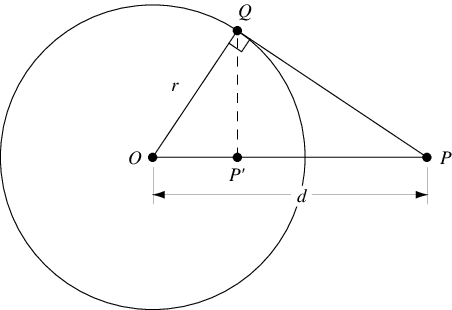The power of a fixed point with respect to a circle of radius
and center
is defined by the product
|
(1)
|
where
and
are the intersections of a line through
with the circle. The term "power"
was first used in this way by Jacob Steiner (Steiner 1826; Coxeter and Greitzer 1967,
p. 30). Amazingly,
(sometimes written
)
is independent of the choice of the line
(Coxeter 1969, p. 81).

Now consider a point
not necessarily on the circumference of the circle. If
is the distance between
and the circle's center
, then the power of the point
relative to the circle is
|
(2)
|
If is outside the circle,
its power is positive and equal to the square of the
length of the segment
from
to the tangent
to the circle through
,
|
(3)
|
If lies along the x-axis,
then the angle
around the circle at which
lies is given by solving
|
(4)
|
for , giving
|
(5)
|
for coordinates
 |
(6)
|
The points
and
are inverse
points, also called polar reciprocals, with respect to the inversion
circle if
|
(7)
|
(Wenninger 1983, p. 2).
If is inside the circle,
then the power is negative and equal to the product
of the diameters through
.
The powers of circle of radius with center having trilinear coordinates
with respect to the vertices of a reference
triangle are
 |
(8)
| ||
 |
(9)
| ||
 |
(10)
|
(P. Moses, pers. comm., Jan. 26, 2005). The circle function of such a circle is then given by
|
(11)
|
The locus of points having power with regard to a fixed circle
of radius
is a concentric circle
of radius
. The chordal theorem
states that the locus of points having equal power
with respect to two given nonconcentric circles is a line
called the radical line (or chordal; Dörrie
1965).